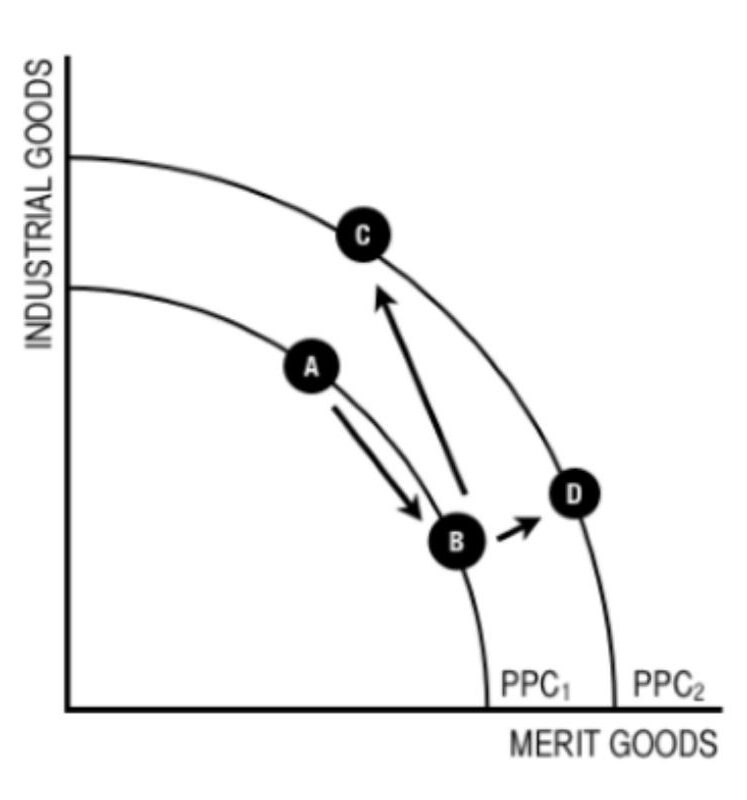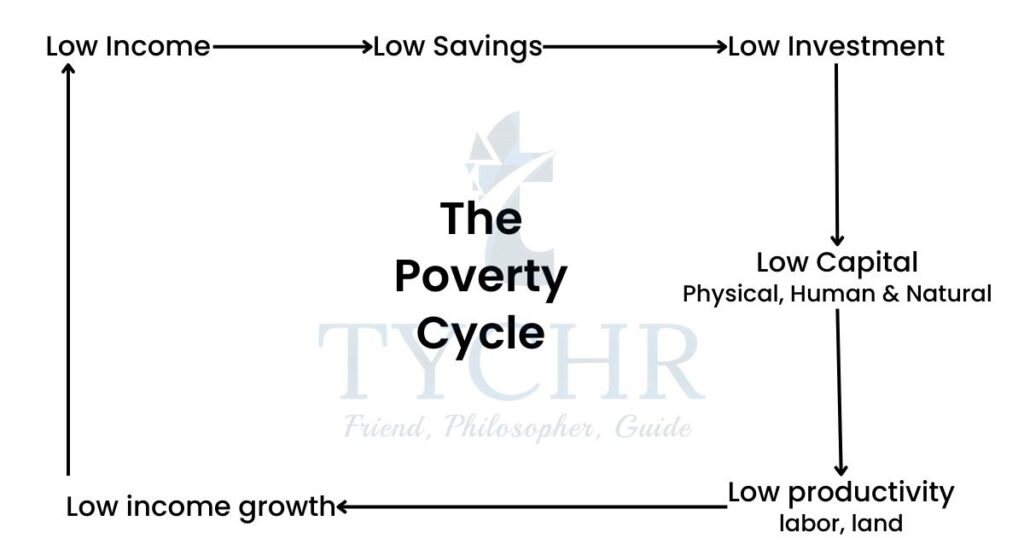understanding economic development Notes
Economic development involves improving living standards, economic growth, and social progress. This study note explores key concepts and theories of economic development, covering measures of development, influencing factors, development strategies, and challenges faced by developing countries, all relevant to the IBDP Economics syllabus. Understanding these issues is crucial for analyzing global economic disparities.
Economic growth and development
- Economic growth – increases in output and incomes over time Usually measured per capita.
- Economic development – process that leads to improved standards of living for a population.
- Economic growth can result in economic development, but it is not guaranteed.
- Economic development changed over years:
- In 1950-60s, economists thought that growth was the same as development
- Trickle-down theory – benefits of growth would “trickle down” to everyone
- Current view of economic development: process where increases in real per capita output and incomes are accompanied by improvements in standards of living and increased access to goods and services that satisfy basic needs.
- Human development defined with three core values:
- Life sustenance (access to basic services and needs)
- Self-esteem (feeling of self-respect; absence of exploitation), and
- Freedom (the ability to make choices that people in poverty cannot).
- Income poverty is when income falls below a poverty line.
The inability to “lead a long, healthy, creative life and to enjoy a decent standard of living, freedom, dignity, and the respect of others” is known as human poverty.
Sources of economic growth in economically less developed countries
- Sources of economic growth are the same everywhere. In less-developed places certain sources are more important.
- Increases in physical capital – physical capital quantity makes possible increases in labor productivity.
- Increases in human capital – increases labor productivity. In developing countries, more labor can improve productivity.
- Development/use of new technologies – technology contributes to growth, but they need to be appropriate and fitting for the location.
- Institutional changes – there is a need to develop institutions for property rights, a legal system, a tax system, because a market system cannot function well without them.
- Commodity-type natural resources – there is a trend (curse of natural resources) where resource-poor developing countries are growing faster than resource-rich countries.This is because resource-poor nations cannot rely on the production of commodities, so they diversify earlier. Countries with a lot of resources rely on their volatile exports.
Economic growth and economic development, again
- Economic growth can occur without development. Development is possible if policies to provide social services are followed.

- Showed on PPC with merit and industrial goods. • A → B: no economic growth, some development • B → C: economic growth, no development • B → D: economic growth with development
Distinguishing between more and less developed countries
- The World Bank divides countries based on their GNI per capita.
- Economically less developed countries:
- Low income (GNI per capita < $975
- Lower middle income (GNI per capita $976-$3855)
- Upper middle income (GNI per capita $3856-$11905)
- Economically more developed countries
- High income (GNI per capita >$11906)
- The less developed countries include countries in Africa, Asia, Latin America, and some former Soviet countries. More developed countries include North America, Western Europe, Japan, New Zealand, and some oil producing Middle Eastern countries.
- Classifying countries by GNI does not represent the level of development!
- Classifying countries by GNI also hides the lack of uniformity – some countries still have poverty in some places.
Common characteristics of developing countries
- Low levels of GDP/GNI per capita
- Economically less developed nations, by definition, have GNI per capita levels below a certain threshold.
- High levels of poverty
- Almost all extreme poverty and most moderate poverty are concentrated in less developed countries.
- Relatively large agricultural sector
- Due to YED for agricultural products
- Large urban informal sector
- Informal sector refers to unregistered/unregulated economic activities. A lot of them exist in developing countries. Examples: carpenters, pedicab drivers, vendors, etc.
- In developing countries, these activities are undertaken for survival. In developed countries, these activities are undertaken to avoid taxes, labor, or legislation.
- 1/2 to 3/4 of non-agricultural employment in the informal sector.
- Size and growth due to policy failures that focused on industrialization and population growth.
- Informal sector has many problems: no protection, exploitation, hazards, slums, etc.
- Seen as an opportunity for increased employment opportunities.
- High birth rates and population growth
- Developing countries have higher birth rates and population growth.
- Ratio of dependence—individuals who require the assistance of the working population
Developing countries have a higher dependency ratio because of the large proportion of children. Families need to spread their income among more people. - Increases in population will burden the developing world – need to absorb more employment opportunities, pressures on environment, quality of health, education, etc.
- Rapid population growth requires more rapid output and income growth.
- High population growth results in high dependency; less income per person.
- Negative consequences for mothers whose health is affected by childbirth. Environmental degradation.
- Low levels of health and education
- Low levels of productivity
- Low levels of health and education and scarcity of capital goods result in low productivity.
- Dual economy
- Dual economy – when there are two different/opposing circumstances that exist together.
- Wealthy and poor, formal and informal, high-productivity and low-productivity, commercial sector and agricultural sector.
- The goal of economic development is to standardize social structures by reducing dualism.
The poverty cycle
- Poverty can cause poverty.
- Poor people spend their incomes on survival essentials. They have little capital and natural capital gets destroyed. To come out of poverty, they need more capital, which can only be made by saving. They cannot save because they need their essentials. This creates a poverty trap.
- Poverty is transmitted across generations:
- Low income earners have low productivity, cannot send children to school, cannot provide enough food for the family, and have large families.
- Children grow into adulthood without skills.
- Poor people need intervention to break out of the poverty cycle, such as the government investing in capital.
- They also need the government to allow poor people to participate in private sector activities.
- If a country is trapped in the cycle, foreign aid is needed.

Diversity among less developed countries
- Resource endowments
- Countries have natural resource endowments that can be marketable.
- Less developed countries have more labor resources, and more developed countries have more capital. This affects their pricing.
- Resource endowments play a role by determining the type of specialization.
- Climate
- Climate determines economic activities – heat reduces productivity, tropical climates reduce soil quality.
Most developed countries have temperate climates.
- Climate determines economic activities – heat reduces productivity, tropical climates reduce soil quality.
- History
- Most developing countries are former European colonies. These colonies were set up to extract resources. These colonies have not reformed even post- independence.
- Political system
Countries have different political systems, like monarchies, democracies, etc. - Political stability
- Stable government necessary for gov’t decision making and making policies.
- Instability creates uncertainty, outflow of capital, and increased vulnerability to hunger and famine.
- Low levels of income per capita related to political instability.
International development goals

- Millennium Development goals are targets that want to be achieved within 15 years that come with indicators used to monitor progress.

MEASURING ECONOMIC DEVELOPMENT
Complexities of measuring economic development
- No single measure itself can measure economic development. Indicators, or measurable
variables that indicate the state of something measured, are used. GDP per capita is an
indicator of output level. - Indicators can
- Help monitor how a country changes over time,
- Help make comparisons between countries,
- Help assess how well a country is performing, and
Help devise appropriate policy measures to deal with problems.
- There are also composite indicators, which are summary measures of several goals of
development.
Single indicators
- GDP indicates the value of output produced within a country. GNI indicates the income received by the residents. (Usually measured in per capita.)
- When a country has many workers from other countries and sends profits back home, the country’s GNI is lower than its GDP because wages of foreigners are not included.
- GNI per capita is a better indicator of standards of living.
- In high-income countries, GNI and GDP differ only about 10%. In middle/low income
countries, the differences are can also quite small. They can also be large, due to large
amounts of worker remittances. - GNI/GDP can give misleading results because money has a greater purchasing power in a
high price country. - Purchasing power parity is the amount of money needed to buy the same amount of
goods and services in one country for one dollar in the United States. - For poorer countries, GDP based on PPPs are higher than those based on exchange
rates. For wealthier countries, GDP figures based on PPPs are lower. - Price of g/s is lower in countries with low per capita GDPs.
- Health indicators measure characteristics of populations related to health, such as life
expectancy, infant mortality, and maternal mortality. - Life expectancy at birth – number of years one can expect to live.
- Infant mortality – number of infant deaths from birth to age of one, per 1000 live births
- Maternal mortality – number of women who die due to pregnancy and related causes,
per 100000 live births. - Higher GDPs per capita have higher life expectancies and lower mortalities, but there are
patterns that show that income is not the only factor. - Life expectancy is higher, and mortality is lower when there are:
- adequate services for public health and disease prevention
- adequate health care services with broad access a healthy environment and low pollution
- adequate diet and avoidance of malnutrition
- high level of education
- poverty and severe income disparities are absent.
- Outcomes depend on how countries achieve objectives
Some countries have inequality in income and education to cause poverty. - Education indicators measure levels of educational attainment, such as literacy rate,
enrolment in primary school, and enrolment in secondary school. - Usually high-income countries have higher indicators, although some low-income
countries also have such rates, especially former Soviet countries because communist
countries have a high priority on education. - Secondary education is less of a priority for some countries; because they must use
resources to first provide primary education. - The World Bank compiles a set of indicators.
Composite indicators
- The human development aspects are measured by composite indicators, which are summary measures of more than one dimension.
- Human Development Index – summary measure of human development with three
dimensions: 1) long and healthy life (life expectancy at birth), 2) access to knowledge
(mean years/expected years of schooling), and 3) a decent standard of living (measured
by GNI per capita US$ PPP) - Each dimension between 0 (low) and 1 (high), and the composite index is the average of the three dimensions.
- HDI also has shortcomings, because economic and human development has more
dimensions not shown in the HDI. - Some countries have similar HDIs, but ones with a lower GNI show that they can achieve
a similar level of human development with a lower GNI.
Economic development is a complex and ongoing process. This study note has covered essential concepts and theories. Applying these to real-world cases and analyzing policies is key. For personalized support in IB DP Economics, including economic development, consider a tutor. TYCHR connects students with experienced IB Economics SL & HL tutors. A solid understanding of development is crucial for engaging with global economic issues and IB Economics success.

